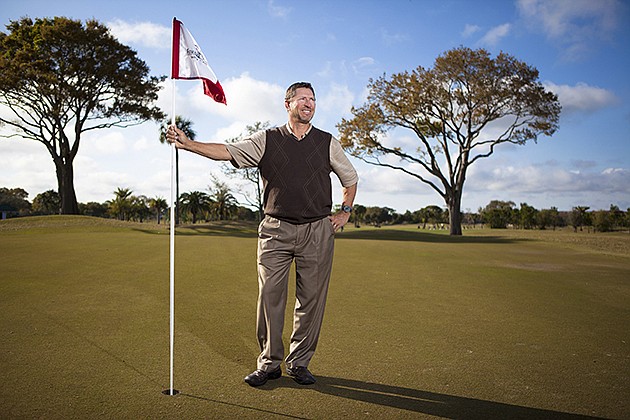Executive Summary
Company. Marcus & Millichap Industry. Real estate Key. As golf declines, redevelopment of abandoned courses provides many challenges.
Florida has more golf courses than any other state. There are more than 1,200 courses, one for every mile of sand beaches Florida boasts.
But golf took a serious hit during the most recent recession, and its rebound has been far slower than expected, despite green fees at just a quarter of what they were a decade ago.
That has put a lot of golf courses in limbo. Between 2011 and 2013, the United States experienced a net loss of 500 golf courses, and 2014's numbers are expected to be just as bad, says Steven Ekovich, director of Marcus & Millichap's national golf division.
The sport's decline has squeezed a niche segment of housing construction on the Gulf Coast: golf course home developments.
“Who thought 20 years ago when a lot of these golf courses were being built that people today would instead be out mountain climbing, riding Harley-Davidsons, or doing something other than golf?” says Ekovich, based in Tampa. “And the millennials, those 17- to 34-year-olds, we've lost a significant portion of them because the recession really hit them the hardest.”
The golf courses that do stay open are trapped in pricing wars that have caused the average price of a golf round to plummet from $70 to less than $30, Ekovich says. On top of that, initiation fees that once cost between $70,000 and $100,000, now cost as low as $5,000.
“The average golfer is a winner in all this,” Ekovich says. “The losers are those who didn't know how to manage through these tough times, or simply weren't in the business for the right reasons in the first place.”

The once pristine Plantation Palms golf course in Pasco County is now a wasteland in the middle of a subdivision. The price tag to bring a golf course like this back online is more than $1 million. Photo by Michael Hinman
Deteriorating conditions
Golf courses that sit vacant aren't like other properties, and that exacerbates the situation.
Distressed property management was a valuable skill to have during the recession. Buildings and vacant land could sit without maintenance for months, maybe even years, and still come out of the economic downturn in decent shape.
Golf courses, however, don't have the same shelf life.
“If it's not being irrigated and maintained, you're going to have a lot of things go wrong,” says Hilda Allen, a Georgia-based golf course broker in the Southeast with Hilda W. Allen Real Estate. “If you let it go, even for a few weeks, it could be almost impossible to bring it back as a golf course.”
 Homeowners in Pasco County's Plantation Palms community have been saddled with an abandoned golf course in the middle of the subdivision for nearly a year. MJS Golf Club LLC closed the course in May and immediately stopped maintaining the grounds.
Homeowners in Pasco County's Plantation Palms community have been saddled with an abandoned golf course in the middle of the subdivision for nearly a year. MJS Golf Club LLC closed the course in May and immediately stopped maintaining the grounds.
Within weeks, the pristine greens were gone, and in just a few months, the golf course was virtually unrecognizable. The Plantation Palms homeowners association was powerless to intervene because the golf course was privately owned, and was basically just another member of the association.
Last fall, the golf course went back on the market, listed for $1.2 million -- nearly half of what MJS Golf paid for it in 2011.
“Developers are losing interest in golf courses right now,” says John Rymer, president of the real estate consultant firm Rymer Strategies in Tampa. While homebuyers are still willing to pay premiums to buy homes abutting the greens, the golf courses themselves have siphoned profits from the developers.
“Some of those developers have chosen to bundle golf with home purchases,” Rymer says. “That gives you an automatic membership base and revenue stream. But the standalone systems are a very, very unique situation, where the high maintenance costs are just the same, whether you have one member or 350.”
New uses
Plantation Palms has limited options on how to handle an abandoned golf course in the middle of a community.
But other failed golf courses are making way for new development, such as Mirabella at Village Green in Bradenton. Developers Marshall Gobuty and David Koral are transforming what was once the Village Green golf course there in into 160 attached villas for a senior citizen-oriented “active lifestyle” community.
“The developer here is simply not a golf course owner,” Mirabella spokeswoman Linda Gross says. “It's a nice piece of property that is in more of an urban area, and he (Gobuty) had a vision of an active lifestyle community.”
Other golf courses could transform into uses like parks and even cemeteries, Marcus & Millichap's Ekovich says. But creating new uses has many sand traps developers will want to avoid.
“Repurposing golf courses is very tricky because most of those golf courses are in deed-restricted communities,” Ekovich says. “They were built as amenities to housing developments. And for master-planned communities, the golf course is your green space.”
Homeowners surrounding the course paid premium prices to get views and access to those courses, and those same homeowners would be upset if that money was spent for nothing.
“There is one course outside of Florida where they are digging up the fairways and selling that dirt to the department of transportation,” Ekovich says. “Others in rural areas are being converted back into agricultural land, because it's more valuable as farmland than as a golf course.”
Hope remains
The industry, despite the troubles, isn't without hope.
“People still come to Florida looking to play golf, and the people already living here still want to play golf,” Mirabella's Gross says. “Developers aren't completely abandoning golf courses.”
Some developers actually foretell a golfing renaissance. One of those developers is Canadian homebuilder Mattamy Homes, which already has found success in places like Lakewood Ranch, a large master-planned community in east Manatee County.
Mattamy also bought the former Forest Lakes golf course on South Beneva Road in Sarasota in December for $5.9 million. It unveiled plans to not only build more than 200 townhouses, but to resurrect the 18-hole course that had been abandoned since 2006.
“Golf courses can survive, but you need far more people than you used to if you want to be successful,” real estate consultant Rymer says. “In the past, you could probably support a golf course with just 400 people. But today, because there are fewer rounds being played on average, you really need closer to 550 or 600.”
Another challenge: Today's higher-paced world doesn't necessarily lend itself to spending four hours on a golf course, Ekovich says. Even with cheaper greens fees, many would-be golfers are looking for activities that can better include the entire family. Younger people aren't even looking at golf, many considering it an activity more suited for an older generation.
Despite the challenges, Ekovich says there's still room to be optimistic.
“It's going to right-size, it's going to find its equilibrium,” he says. “Green fees will grow again, memberships will grow again, and things will be great for both owners and lenders.”



 Homeowners in Pasco County's Plantation Palms community have been saddled with an abandoned golf course in the middle of the subdivision for nearly a year. MJS Golf Club LLC closed the course in May and immediately stopped maintaining the grounds.
Homeowners in Pasco County's Plantation Palms community have been saddled with an abandoned golf course in the middle of the subdivision for nearly a year. MJS Golf Club LLC closed the course in May and immediately stopped maintaining the grounds.



